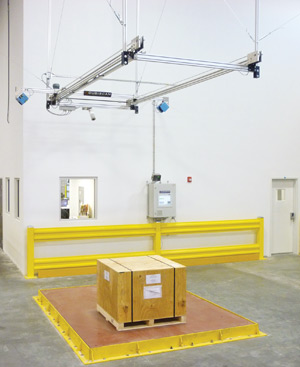Shift Toward Density-Based Pricing Depends on Shippers, LTL Execs Say
 Cubiscan
CubiscanThis story appears in the April 20 print edition of Transport Topics.
ORLANDO, Fla. — Wider use of density-based pricing in the less-than-truckload industry will depend on shippers’ willingness to gradually adapt their habits and technology, industry officials said.
Speaking at a Nasstrac meeting here April 15, Famous Footwear’s Terri Reid said, “Shippers need to prepare for the inevitable” shift toward pricing, based on a product’s density, which is derived from length, width and height — and a so-called “density factor” — to determine the freight rate.
Today, the National Motor Freight Classification system predominates for pricing LTL freight. It dates to the 1930s and divides freight into classes based on characteristics that include weight, stowability, dimensions and liability.
Reid, director of transportation and supply chain for the shoe retailer, said many believe switching to density-based pricing will be costly, solely from the expense of changing existing automated pricing systems or installing new ones to compare class and density pricing expenses.
“You have to do studies of how density will affect your system,” she said. “You have to do both types of math — the density-based versus the class system.”
Reid, a shoe shipper, said LTL customers today are in two camps. One supports the existing, familiar system, and the other sees density-based pricing as easier to use and implement.
“This is not going to be forced,” said YRC Freight President Darren Hawkins, who described what he called an “evolution, not a revolution” in moving LTL pricing toward density-based rates.
There have been multiple signs of a transition away from the system that divides freight into 18 classes.
YRC over the past year added machines to determine density at all 23 of its major freight hubs.
The LTL units of UPS Inc. and FedEx Corp. offer density-based rate options. Old Dominion Freight Line and Saia use dimensioners.
In today’s LTL market, Hawkins and Kevin Fletcher, senior vice president of transportation services for Kenco Group, a logistics provider, estimated that less than 10% of freight is moved with
dimensional pricing. Fletcher said that two years ago, dimensional pricing was used for no more than 2% of freight.
Hawkins also said that the acceptance of density-based pricing could rise “dramatically” over the next two years, based on the level of acceptance by other carriers and the shipping community.
Fletcher described “a huge paradigm shift,” saying “no matter what side of the fence you are on, this [density-based] system is going to affect you.”
In addition, he said, shippers may be hamstrung because they will be unable to order other departments that currently package freight to suit the class rating system to change the packaging so that it suits density-based pricing.
“Understand your commodity class and understand your density-based characteristics, and then educate your senior executives about the changes,” he said.
Fletcher also said that some shippers aren’t fully engaged in the pricing process and may not be ready for a changeover.
One indicator of readiness was the fact that just one audience member out of about 150 raised his hand when attendees were asked whether their pricing technology could handle density-based rates.
Hawkins acknowledged that LTL carriers also will use the system to correct abuses by shippers who don’t properly represent what they are moving.
He said carriers’ adoption of density-based pricing is driven in large part by concerns about capacity and availability of drivers.
Hawkins also said that shippers who are willing to collaborate with carriers on pricing and other matters such as reducing waiting time at loading docks can enhance their status as a shipper of choice when capacity decisions are being made.
Fletcher noted that UPS and FedEx shifted this year to dimensional pricing for package shipments and that the ocean shipping industry also bases container rates on density.
“There will be quite a few potholes,” Reid said, adding that package shippers have had to become more familiar with density-based pricing when UPS and FedEx imposed that pricing method on all shipments at the start of 2015.
Joe Wilkinson, director of transportation for consultant enVista, said package rates for his company’s customers have risen between 2% and 18% as a result of the shift to density-based pricing for package shipments.
Like the LTL panelists, he urged shippers to analyze the changes from the pricing strategy shift at both carriers, which began density-based pricing this year for any shipment under 3 cubic feet.




